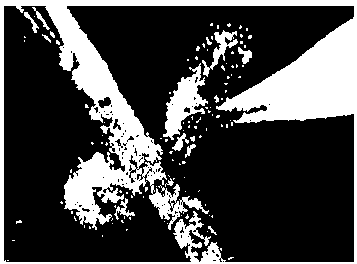Paecilomyceslilacinus strain having strong pathogenicity for diaphorina citri
A technology of Paecilomyces lilacinus and Paecilomyces lilacinus, which is applied in the field of microorganisms and achieves good market application prospects, less resistance to drugs, and strong effects
- Summary
- Abstract
- Description
- Claims
- Application Information
AI Technical Summary
Problems solved by technology
Method used
Image
Examples
Embodiment 1
[0019] Example 1: Isolation and Screening of Entomopathogenic Bacteria
[0020] 1. Isolation and purification of pathogens: Collect citrus psyllid carcasses from citrus orchards in Huangyan District, Taizhou City, Zhejiang Province, bring them back to the laboratory, soak them in 70% ethanol for 30 s, and then soak them in 0.1% mercuric chloride for 3 min. Finally, rinse with sterile water for 3 times, use sterile filter paper to dry the water on the worm body, and then put it on the potato dextrose agar (PDA) medium (preparation method: weigh 200 g of potatoes, wash, peel and cut Crushed, add 1000 mL of water, boil for half an hour, filter with gauze, add 20 g of glucose and 20 g of agar, fully dissolve, filter with gauze while hot, dispense into Erlenmeyer flasks or glass test tubes, autoclave at 121°C for 20 min ), placed in a microbial incubator at a constant temperature of 28°C, until the hyphae grow around the insect body, pick the hyphae and transfer them to a new PDA p...
Embodiment 2
[0024] Embodiment 2: Identification of bacterial strain ZJPL08
[0025] 1. Morphological characteristics of the strain ZJPL08: Inoculate the isolated and purified strain ZJPL08 in the center of the PDA medium plate, place it in a constant temperature culture at 28°C, observe the growth of the colony every day and record the color and shape of the colony. Inoculate the strain ZJPL08 into the center of another PDA medium plate, insert the sterilized cover glass (1 cm×1 cm) obliquely into the medium about 1 cm away from the inoculation point, and place it in a constant temperature culture at 28 °C About 5 days after the hyphae climbed onto the cover glass, the cover glass was taken out and placed under an optical microscope to observe the hyphae and spore morphology of the strain ZJPL08.
[0026] figure 1 The morphological characteristics of the strain ZJPL08 cultured on PDA medium for 7 days are shown. It can be seen that the colony of the strain ZJPL08 is round and raised, th...
Embodiment 3
[0030] Embodiment 3: the biological characteristic of bacterial strain ZJPL08
[0031] 1. Effects of different temperatures on the growth of strain ZJPL08: Use a sterile puncher to punch 5 mm-sized bacterial cakes around the colony of strain ZJPL08 cultured on PDA medium for about 7 days, and then place the bacterial cakes on several The center of each freshly prepared PDA plate (9 cm in diameter) was cultured upside down in light incubators at 5°C, 10°C, 15°C, 20°C, 25°C, 30°C and 35°C respectively, and three plates were set at each temperature. repeat. After culturing for 14 days, the growth of the colony was observed every 24 h and the diameter of the colony was recorded by the cross method.
[0032] The results are shown in Table 1. It can be seen that the strain ZJPL08 can grow on the PDA medium at a temperature of 15°C to 35°C, and the growth rate of mycelium at 25°C and 30°C is significantly higher than that at other temperatures, and it can be cultured for 14 days. T...
PUM
 Login to View More
Login to View More Abstract
Description
Claims
Application Information
 Login to View More
Login to View More - R&D
- Intellectual Property
- Life Sciences
- Materials
- Tech Scout
- Unparalleled Data Quality
- Higher Quality Content
- 60% Fewer Hallucinations
Browse by: Latest US Patents, China's latest patents, Technical Efficacy Thesaurus, Application Domain, Technology Topic, Popular Technical Reports.
© 2025 PatSnap. All rights reserved.Legal|Privacy policy|Modern Slavery Act Transparency Statement|Sitemap|About US| Contact US: help@patsnap.com



